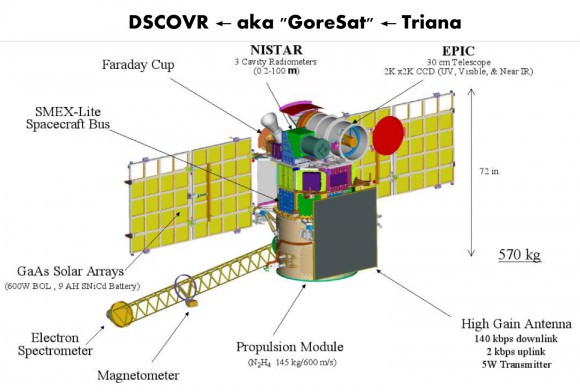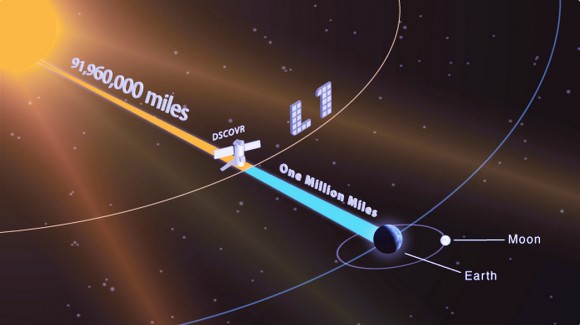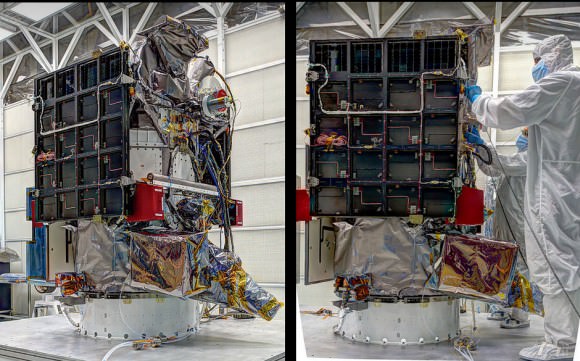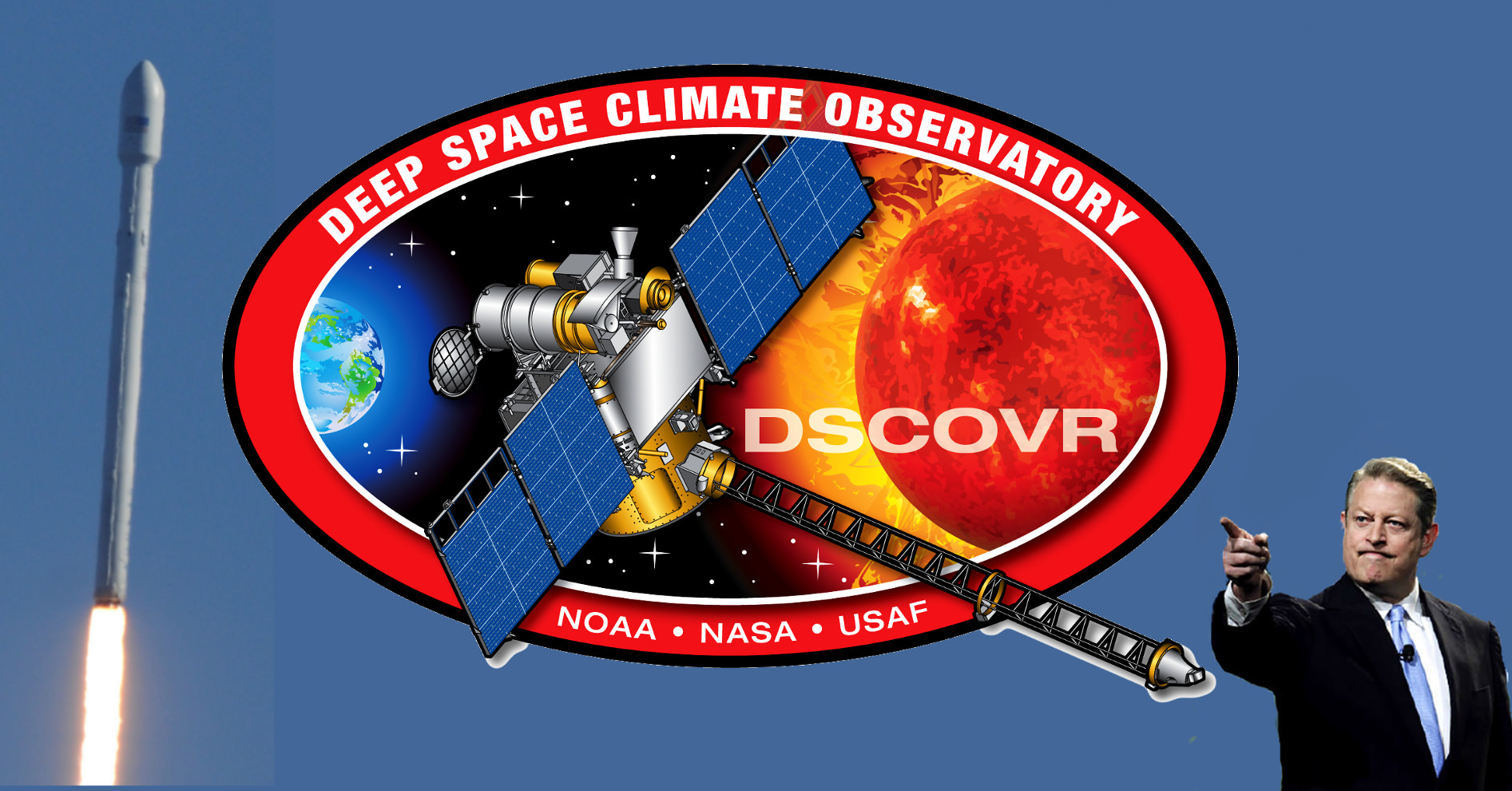For DSCOVR – the payload of SpaceX’s next Falcon 9 launch, waiting one more week is a yawn. The Deep Space Climate Observatory (DSCOVR) spacecraft has withstood a delay of over 12 years. Word from Cape Canaveral is that the Air Force is delaying the launch of the next Falcon 9 until February 9th. Two days earlier, the launch date had been moved to January 31st.
Its original mission name could not be more noble, Triana – the name of Columbus’ sailor that first saw the New World. Then, it got tangled in the ignoble politics of space and climate change. Yet, if all goes well for the SpaceX Falcon 9 launch, the famous GoreSat satellite will be deployed and then immediately upstaged by what everyone agrees is a major milestone – returning a rocket’s 1st stage gently to Earth to reuse and to reduce the cost of space travel.

Remember GoreSAT? Better yet, do you recall the spacecraft Triana? They are one in the same. They are DSCOVR. The spacecraft was completed and ready to be shipped to Cape Canaveral in 2001. It was scheduled for launch on board NASA’s flagship, the Space Shuttle Columbia, on what became Columbia’s ill-fated last mission in January 2003. But DSCOVR had become the spoils of the victor. Bush had defeated Gore and the victor pulled the rug from under Triana.
The political story of the DSCOVR spacecraft is wrapped in the political tug of war over Climate Change. Senator Al Gore had long recognized the risks to humanity, to species extinction and destruction of ecosystems by the human-caused climate change. As vice president, in 1998, Gore proposed to NASA the concept that became Triana to monitor and better understand Climate Change. His political opponents labeled Triana “GoreSat”, and its constant downlink stream of “Whole Earth” images as “an expensive screensaver”.
The former Republican congressman from Texas, Dick Armey, referring to GoreSat, said, “This idea supposedly came from a dream. Well, I once dreamed I caught a 10-foot bass. But I didn’t call up the Fish and Wildlife Service and ask them to spend $30 million to make sure it happened.” This was the rash and risk beholding a spacecraft conceived by politicians. However, while political egos were bruised, Triana, now DSCOVR, was never damaged and was placed into cold storage and for two Bush terms was bathed in pure nitrogen gas to minimize any damage to electronics.

While Solar radiation causes skin damage and melanoma, Solar eruptions – Coronal Mass Ejections (CME) have a global impact – disruption of electrical power grids and damage to Earth orbiting spacecraft. Just as California expects the “big one” and plans for large quakes, DSCOVR is meant to give the Earth an early warning system. According to NOAA and NASA, without monitoring upwind, the big one will cost upwards of $2 trillion in damages including a breakdown of power grids and major satellite systems that the world depends on for transportation, GPS, telecommunications and commerce. In time, a massive CME will happen.
As sure as the Sun rises every morning, DSCOVR was pulled out of storage in November 2008. Despite the years of idle time and technological advances passing it by, DSCOVR still holds an excellent array of instruments. The National Research Council was commissioned to analyze and reported to Congress that Triana was “Strong and scientifically vital.” Beginning in 2009, the instruments were re-certified for flight re-integrated onto the spacecraft bus. Filters were replaced on the 30 cm (12 inch) telescopic camera.
DSCOVR’s Earth Polychromatic Imaging Camera (EPIC) will provide a first of its kinds continuous stream of 8 km resolution global images of the rotating sunlit Earth. The images in 3 bands are in contrast to the future geostationary GOES-R weather satellites (a pair) which will have a 0.5 and 1 km resolution images but only for the western hemisphere. DSCOVR will pair up with ACE to monitor particles and fields streaming from the Sun towards the Earth, 1.5 million km (1 million miles) away.
Three particle and fields instruments will monitor electrons and ions – a top-hat electron electrostatic analyzer and a Farday Cup ion detector; the same type of detectors that were recently flown on the Philae lander to comet 67P. The third Plasma instrument is a pair of fluxgate magnetometers designed and constructed by the late Dr. Mario Acuna’s magnetometer team at Goddard Spaceflight Center. Lastly, targeting its interest in Climate Change, the NiStar instrument developed at Ball Aerospace “is a cavity radiometer designed to measure the absolute, spectrally integrated irradiance reflected and emitted from the entire sunlit face of the Earth”, as stated in NOAA documentation.

DSCOVR now becomes the legacy to a long line of Solar-Terrestial monitoring spacecraft. If you recall last August 10th, the spacecraft ISEE-3 flew past the Earth after over 20 years out of contact and 35 years in space. ISEE-3 became the first vehicle to utilize the Sun-Earth Lagrangian point 1 (L1) to monitor the Solar wind. Several vehicles followed, specialized probes even clusters were developed to understand the complex interaction between the Sun and the Earth’s magnetic field and atmosphere.
DSCOVR will join two existing vehicles – the aging Advanced Composition Explorer (ACE) and the Solar Dynamics Observatory (SDO). Altogether, a next generation of monitoring and, as NOAA emphasizes, development of space weather forecasting and a warning system will evolve from addition of DSCOVR. This also represents SpaceX first contracted launch in the Orbital/Suborbital Program (OSP)-3 NASA program. The second contracted (OSP)-3 launch will be atop the Falcon Heavy expected later in 2015.
References:


As far as a warning platform goes, why is it that SDO can’t serve in that role?
SDO is in an inclined geosynchronous orbit. The incline keeps it out of the Earth’s shadow for all but brief periods each year. Being only about 22K miles away, it can’t give sufficient forewarning; also it can’t see the actual solar wind being it is inside the Earth field. We can visually see CMEs initially but then one must have a L1 monitor to recognize if its been guided by the (Sun’s) interplanetary magnetic field and is on an intercept with Earth.
Of course the climate science deniers are afraid of what this instrument might reveal.
Yes, there are some like that and some of whom hold office. Detractors double the cost of this mission and it could have provided these useful observations ten years ago. The findings could have added to evidence and led to the US, China and others acting sooner and more aggressively. I think the constant imaging and the radiometer are very useful and are not a screensaver maker, etc., etc. There is discovery to be had and we’ll have to wait and see what is gained over months and years of constant monitoring. It could be surprising.